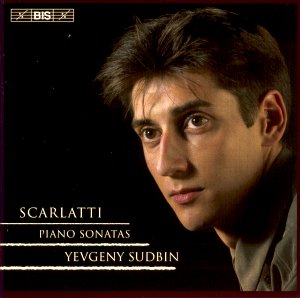"Reader […] show
yourself more human than critical and
then your pleasure will increase."
With these words as preface to the publication
of his sonatas in 1738, Scarlatti provided
a timely reminder to anyone – particularly
a critic – of the perils of over-criticism.
Such is the constant invention shown
within the sinews of the 555 sonatas
he penned that he need not have worried,
having held the constant attention of
players and audience alike.
I have much anticipated
this recording since hearing Yevgeny
Sudbin in recital at Wigmore Hall earlier
this year. (There is a review of this
recital on the Seen
and Heard site. It is the first
of three under his new contract with
BIS. Saint Petersburg born Sudbin is
clearly a young artist with a formidable
technique and enquiring mind.
The task of showing
a cross-section of Scarlatti’s sonata
output is not easy. Sudbin’s choice
of eighteen favours the later sonatas,
whilst taking in examples that cover
a range of forms (including the fugue),
wide variety of moods from savage to
refined, and effects inherent within
the writing: brass, woodwind, drums
and bells. The recital starts in gloriously
upbeat fashion – the bright and well
focussed piano has just enough bloom
in the middle register, and slight (though
appealing) edge to the top register
bring a harpsichord to mind, fittingly
so in this repertoire.
In contrast the second
sonata presented (K. 466) is more reflective
and inward looking, caught as most are
here with a good sense of space around
the notes that allows inner thoughts
to come through. Throughout the sequence
mixes the works to play off one against
another to bring out a different facet
of a jewel within a setting. The ease
with which Sudbin throws off the technical
demands of the works does not overshadow
his musical instinct, or those inherent
within sonatas. Rhythmically alive,
each holds the attention from the first.
Periodically textures in the lower register
faster passages become slightly muddied
– caused more I suspect by the writing
than the playing – prompting one to
question how they might sound on a harpsichord.
Sudbin’s suggestion that Scarlatti anticipated
the modern piano is interesting, as
is the reticence of harpsichordists
in taking up this repertoire today.
As I have suggested,
Sudbin’s booklet note adds further to
the pleasure of the recording, describing
in detail the Spanish court that gave
birth this unique harvest of fruit,
and a brief reflection on the revival
of interest in the sonatas, mentioning
Sudbin’s most prominent rivals on disc:
Michelangeli, Haskil and Lipatti. Whilst
I would not be without any of these
illustrious pianists’ recordings, Sudbin
provides his own insights, although
he does not perhaps "seemingly
do nothing and in so doing do everything"
(to quote Lipatti on Haskil’s Scarlatti
playing). Amongst pianists of the younger
generation that have taken on Scarlatti
- Artur Pizarro or Joanna MacGregor
(originally on Collins Classics, hopefully
to be soon reissued) or Mihaela Ursuleasa
- Sudbin also holds his own. Just occasionally
do I wish that Sudbin had found more
touches of wit within individual sonatas.
In summation then,
a pianist to watch out for, and a recording
that need not fear critical listening,
for it certainly has much pleasure to
give to anyone wishing to discover or
extend their appreciation of this rich
vein of keyboard writing.
Evan Dickerson

